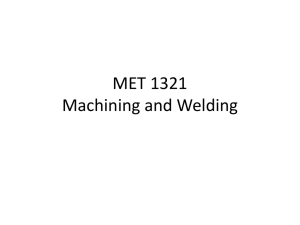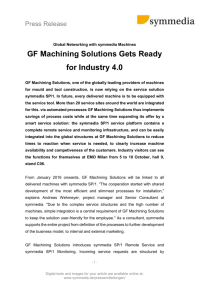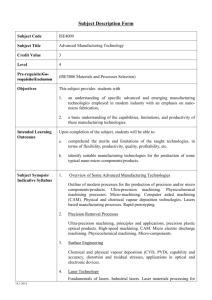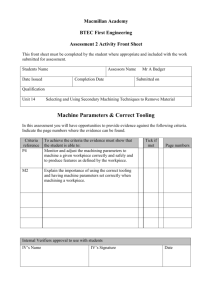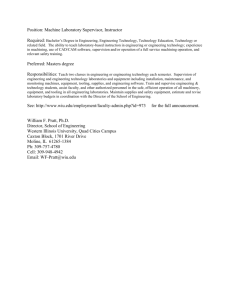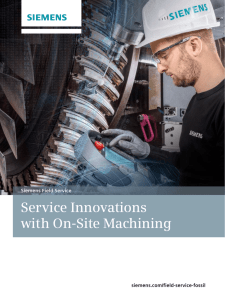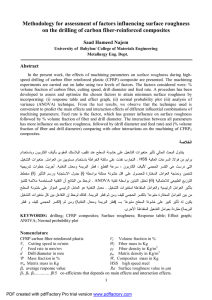MT 101 Syllabus
advertisement
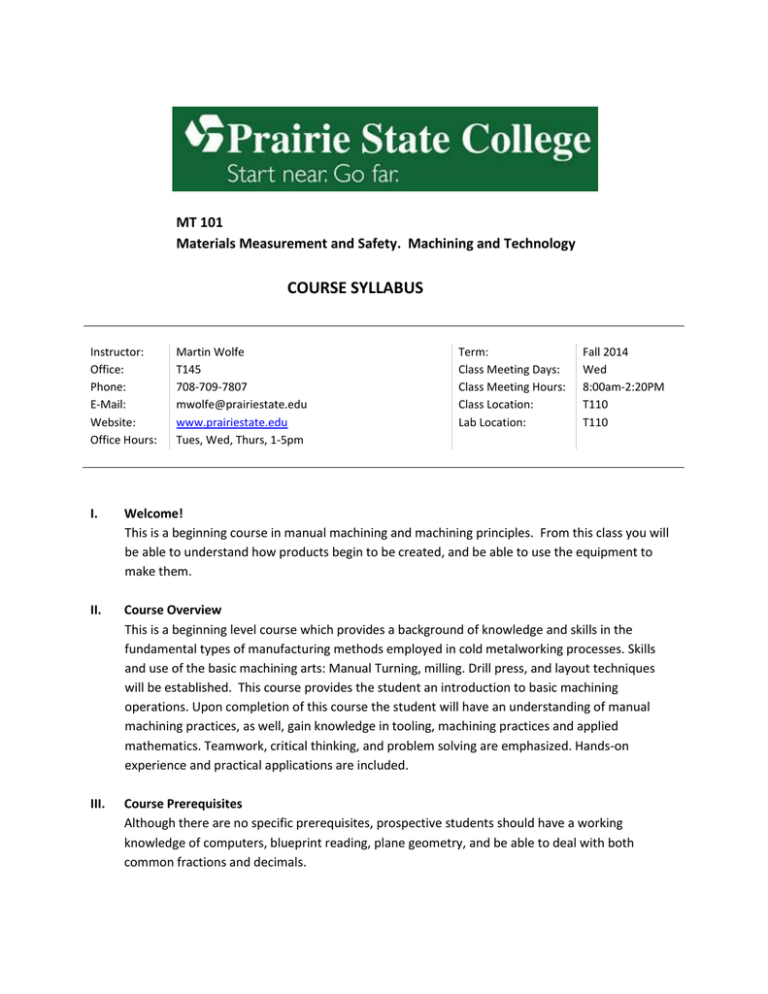
MT 101 Materials Measurement and Safety. Machining and Technology COURSE SYLLABUS Instructor: Office: Phone: E-Mail: Website: Office Hours: Martin Wolfe T145 708-709-7807 mwolfe@prairiestate.edu www.prairiestate.edu Tues, Wed, Thurs, 1-5pm Term: Class Meeting Days: Class Meeting Hours: Class Location: Lab Location: Fall 2014 Wed 8:00am-2:20PM T110 T110 I. Welcome! This is a beginning course in manual machining and machining principles. From this class you will be able to understand how products begin to be created, and be able to use the equipment to make them. II. Course Overview This is a beginning level course which provides a background of knowledge and skills in the fundamental types of manufacturing methods employed in cold metalworking processes. Skills and use of the basic machining arts: Manual Turning, milling. Drill press, and layout techniques will be established. This course provides the student an introduction to basic machining operations. Upon completion of this course the student will have an understanding of manual machining practices, as well, gain knowledge in tooling, machining practices and applied mathematics. Teamwork, critical thinking, and problem solving are emphasized. Hands-on experience and practical applications are included. III. Course Prerequisites Although there are no specific prerequisites, prospective students should have a working knowledge of computers, blueprint reading, plane geometry, and be able to deal with both common fractions and decimals. IV. Course Credits 4 credit hours V. Required Texts and Materials Text: Precision Machining Technology, Hoffman Peter J. Hopewell, Eric S. Delmar/Cengage Learning. You will also need the accompanying workbook with the text. VI. Expected competencies/outcomes At the completion of this course, the students will, given the appropriate special tools and equipment, be able to safely perform the attached list of tasks with a degree of proficiency and in a period of time deemed satisfactory by the instructor. VII. Disability Access: Prairie State College is committed to providing reasonable accommodations for all persons with disabilities. This syllabus is available in alternate formats upon request. Students who need accommodations must be registered with Student Disability Services, Attendance Policy: Attendance is expected and records will be maintained. Consistent attendance is essential for success in this course. Tardiness and leaving class/lab early will also be noted. People entering the classroom late should take the instructor and students into consideration. Poor attendance not only denies the individual student instruction but also denies the class of the unique perspective of that student. For these reasons, on the third absence, the final letter grade will be lowered one full letter grade. Each additional two absences will lower your final grade an additional letter. Professionalism Policy: Per college policy and classroom etiquette; mobile phones, iPods, etc. must be silenced during all classroom and lab lectures. Those not heeding this rule will be asked to leave the classroom/lab immediately so as to not disrupt the learning environment. Please arrive on time for all class meetings. Students who habitually disturb the class by talking, arriving late, etc., and have been warned may suffer a reduction in their final class grade. Academic Conduct Policy: Academic dishonesty in any form will not be tolerated. If you are uncertain as to what constitutes academic dishonesty. As in all College courses, the student handbook Rules of Conduct will be applied. Violations of these rules will result in a record of the infraction being placed in your file and receiving a zero on the work in question AT A MINIMUM. At the instructor’s discretion, you may also receive a failing grade for the course. Confirmation of such incidents can also result in expulsion from the College Methods of Evaluation: The norm expected in the workplace is “Excellence”. The same is expected of your work in this course. Grading criteria: Class work/Safety 25% Excellent performance (your best) earns you an A Projects 40% Good performance (moderate effort) earns you a B Midterm Exam 10% Final Exam 20% Attendance, quizzes/Classroom 15% Mediocre performance (little effort) earns you a C Poor performance (minimum effort) earns you a D Course Goals/Objectives Upon successful completion of this course, students will be able to: ● 1. The student will be able to apply appropriate safety rules and procedures. ● The student will be able to identify basic blueprint symbols and lines. ● The student will be able to demonstrate proper care and safety for a drill press. ● The student will be able to perform appropriate drill press operations. ● The student will be able to demonstrate proper care and safety for a vertical mill. ● The student will be able to perform appropriate vertical mill operations. ● The student will be able to demonstrate proper care and safety for horizontal and vertical power saws. ● The student will be able to perform appropriate saw operations. ● The student will be able to demonstrate proper care and safety for an engine lathe. ● The student will be able to perform appropriate engine lathe operations. ● The student will be able to apply appropriate bench work skills and safety practices. ● Demonstrate skills in mathematical concepts related to precision machining including but not limited to basic fractions, reading scales and measuring tools, conversion of fraction/decimal measuring, conversion of metric/English measuring, Algebra concepts) ● The student will gain important employability skills including but not limited to communication skills (verbal and written), working as a team, problem solving, accountability, and attendance) Detailed topical course outline 1. Learning Outcomes – Core Abilities A. Critical Thinking B. Professionalism C. Mechanical Aptitude: Determine the Proper Method/Equipment to Manufacture and Measure Characteristic of a Part D. Technological Literacy E. Recognize and Avoid Shop Hazards I. Explore Shop Floor Layout 2. Learning Objectives A. Explain General Shop Layout B. Differentiate Conventional Machinist, Programmer, CNC Machinist C. Apply Housekeeping Standard D. Demonstrate Mechanical Aptitude II. Identify Safety A. Explain Key Safety Terms B. Demonstrate Personal Protective Equipment (PPE) C. Apply Lockout/Tag-Out D. Use Guards and Barriers E. Adapt Personal Protective Equipment (PPE) F. Acknowledge OSHA Guidelines III. Explain Types of Machines A. Demonstrate Safety Practices B. Explain Personal Protective Equipment (PPE) C. Apply Lockout/Tag-Out Procedure D. Use Guards and Barriers IV. Apply Measurement Systems and Machine Tool Math A. Explain the English System B. Explain the Metric System C. Apply Fractional Operations D. Use Basic Geometry, Trigonometry and Ratios E. Demonstrate Fractional/Decimal Conversions F. Recognize Tolerances on a Print G. Explain Numbering the Find on a Print (Tenths, 150 millionths, etc.) H. Articulate Numbering Systems Found on Prints (Tenths, Millionths, etc.) V. Define Major Machine Tools A. Explain Machine Differences B. Use Drill Press C. Demonstrate Sawing Machine D. Differentiate Hand Tools E. Identify Lathe, Mill and Various “Axes” F. Learn the Names and to Identify Types of Drills, Mills, and Insert Tooling VI. Utilize Semi-Precision Measurement Tools A. Explain Key Measurement Terms B. Demonstrate Calipers Use C. Use Adjustable Squares D. Apply Angular Measurements E. Demonstrate Fixed Gage Applications VII. Utilize Precision Measurement Hand Tools A. Explain Precision Measurement B. Use Precision Fixed Gages C. Demonstrate Surface Plates D. Characterize Vernier Measuring Tools E. Use Micrometers VIII. Learn Special Measurement Tools A. Identify Coordinate Measuring Machine B. Define Optical Comparator Operation C. Explain Toolmaker’s Microscope IX. Apply Quality Assurance Planning A. Apply Quality Practices B. Compare Inspection and Preventative Processes C. Calculate Average, Standard Deviation, and Determine Capability Range (Average +/3 Standard Deviations) D. Develop Sampling Plan E. Create Inspection Plan F. Define Statistical Process Control (SPC) G. Define Differences between Attributes and Variables (Surface Finish/Appearance vs. Measureable) X. Differentiate Raw Material Composition A. Explain Ferrous Metals B. Explain Nonferrous Metals C. Define Tempering D. Describe Heat Treatment Process E. Characterize Hardness Scales and Test Variety of Specimens XI. Adopt Maintenance Schedules A. Communicate Lubrication Needs B. Use Cutting Fluids C. Demonstrate Measuring of Cutting Fluid Techniques D. Explain Methods of Application XII. Categorize Heat Treatment of Metals A. Distinguish Direct, Surface and Case Hardening B. Distinguish Tempering, Anodizing and Normalizing C. Analyze Hardness Scales and Testing XIII. Communicate Knowledge Learning Objectives A. Take Detailed Notes B. Ask Questions to Industry Representatives C. Practice Problem-Solving and Manual Dexterity D. Communicate with Team Members E. Identify and Properly Name Shop Tools, Components, Supplies, and Equipment This workforce solution was funded by a grant awarded by the U.S. Department of Labor’s Employment and Training Administration. The solution was created by the grantee and does not necessarily reflect the official position of the U.S. Department of Labor. The Department of Labor makes no guarantees, warranties, or assurances of any kind, express or implied, with respect to such information, including any information on linked sites and including, but not limited to, accuracy of the information or its completeness, timelines, usefulness, adequacy, continued availability, or ownership. This solution is copyrighted by the institution that created it. Internal use, by an organization and/or personal use by an individual for non-commercial purposes, is permissible. All other uses require the prior authorization of the copyright holder.

